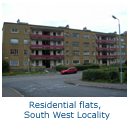Research Findings: Where people live: Impact of where people live on their health Summary papers
Are changes in food retailing damaging our health?
 Food retailing in the UK has undergone major changes in recent years which as seen a rise in large out-of-town supermarkets and reduction in the smaller independent local grocery shops. This has resulted in some gains for consumers in terms of lower food prices and availability of healthier choices, although these are not experienced equally across all social groups. Rising obesity rates in Scotland and associated health conditions such as heart disease and diabetes have highlighted the need to ensure access to affordable healthy food particularly in deprived areas where health is poorer and the availability of fruit and vegetables, and the amount of these which people eat is low.
Food retailing in the UK has undergone major changes in recent years which as seen a rise in large out-of-town supermarkets and reduction in the smaller independent local grocery shops. This has resulted in some gains for consumers in terms of lower food prices and availability of healthier choices, although these are not experienced equally across all social groups. Rising obesity rates in Scotland and associated health conditions such as heart disease and diabetes have highlighted the need to ensure access to affordable healthy food particularly in deprived areas where health is poorer and the availability of fruit and vegetables, and the amount of these which people eat is low.
 This project explored the food shopping habits and priorities among those in their mid-40s and mid-60s living in four socially different neighbourhoods in Glasgow from the Twenty-07 study. We found that people on low income were more likely to give priority to price when shopping for food. Overall we found most grocery shopping is done in supermarkets however, low-income groups and those living in more disadvantaged areas were more likely than higher-income groups to shop for basic foodstuffs such as bread, milk, fruit and vegetables in local shops where prices tend to be higher and the quality and availability of fresh fruit and vegetables is low. This study adds support to the need for policy makers to focus interventions on local neighbourhoods and community base activities around food supply issues.
This project explored the food shopping habits and priorities among those in their mid-40s and mid-60s living in four socially different neighbourhoods in Glasgow from the Twenty-07 study. We found that people on low income were more likely to give priority to price when shopping for food. Overall we found most grocery shopping is done in supermarkets however, low-income groups and those living in more disadvantaged areas were more likely than higher-income groups to shop for basic foodstuffs such as bread, milk, fruit and vegetables in local shops where prices tend to be higher and the quality and availability of fresh fruit and vegetables is low. This study adds support to the need for policy makers to focus interventions on local neighbourhoods and community base activities around food supply issues.
Ellaway, A. and S. Macintyre (2000). "Shopping for food in socially contrasting localities." British Food Journal 102 (1): 52-59.
“Location, Location, Location”
What can we do to support people to adopt healthier lifestyles in their local community? Current health promotion messages suggest people should exercise more and eat healthier so we looked at how easy it was for residents in our study areas to take up these messages. We located four neighbourhoods within two socially different areas in Glasgow in the Twenty-07 Study, one in the North West (West End and Garscadden) and one in the South West of the city (Mosspark and Pollock) to find out which aspects of the area in which we live may play an important in generating social differences in people’s health.
 We found that people in the poorer communities (that of the South West of Glasgow) were less likely to do the 20-30 minutes of daily healthy exercise recommended, than those in more affluent communities (that of the North West of Glasgow). Provision of sports and recreational facilities in South West areas was poor and accessibility either by own
We found that people in the poorer communities (that of the South West of Glasgow) were less likely to do the 20-30 minutes of daily healthy exercise recommended, than those in more affluent communities (that of the North West of Glasgow). Provision of sports and recreational facilities in South West areas was poor and accessibility either by own car or public transport to better out-of-area facilities was poorer from these same communities. Furthermore, reported crime, fear of crime and assault, vandalism, litter and rubbish, anti-social behaviour by youths and discarded drug needles and syringes were a problem in more deprived areas, thus offering less inviting surroundings in which to take up healthy exercise out of doors. In terms of healthy eating, this study found evidence of poor access to healthier foods, less availability and higher prices in the more deprived communities of the South West. It was also found that getting along with neighbours, sense of community belonging, safety and trust among those living in poorer communities was limited. It would therefore appear that the certain aspects of socially deprived areas limit the opportunities for people to adopt healthier lifestyles. This study adds further evidence that health promotion policy, and strategies to improve social capital and reduce inequalities in health should take into account both places and people.
car or public transport to better out-of-area facilities was poorer from these same communities. Furthermore, reported crime, fear of crime and assault, vandalism, litter and rubbish, anti-social behaviour by youths and discarded drug needles and syringes were a problem in more deprived areas, thus offering less inviting surroundings in which to take up healthy exercise out of doors. In terms of healthy eating, this study found evidence of poor access to healthier foods, less availability and higher prices in the more deprived communities of the South West. It was also found that getting along with neighbours, sense of community belonging, safety and trust among those living in poorer communities was limited. It would therefore appear that the certain aspects of socially deprived areas limit the opportunities for people to adopt healthier lifestyles. This study adds further evidence that health promotion policy, and strategies to improve social capital and reduce inequalities in health should take into account both places and people.
Macintyre, S. and A. Ellaway (1999). "Local opportunity structures, social capital and social inequalities in health: what can central and local government do?" Australian Journal of Health Promotion 9(3): 165-170.
Poor housing and neighbourhood conditions contribute to poor health
Research tells us that those living in owner-occupied households have better health than those living in public sector rented housing. The quality of people’s housing and its surroundings is a commonly used measure of standards of living and it has been suggested that its association with health may be independent of other measures of material wealth such as income and social class.
 In this study we asked respondents in the 3rd wave of data collected when they were aged 40 and 60 years and living in socially contrasting neighbourhoods in Glasgow (West End, Garscadden, Mosspark and Pollock) whether they rented or owned their home. We then asked if they experienced stressors associated with living conditions such as overcrowding, dampness, hazards, and poor heating, and to stressors associated with the surrounding environment such as crime, noise problems, amenities, neighbourliness, area reputation and satisfaction. We also looked at whether this might help explain differences in long-term illness and mental health between those who own and rent their homes.
In this study we asked respondents in the 3rd wave of data collected when they were aged 40 and 60 years and living in socially contrasting neighbourhoods in Glasgow (West End, Garscadden, Mosspark and Pollock) whether they rented or owned their home. We then asked if they experienced stressors associated with living conditions such as overcrowding, dampness, hazards, and poor heating, and to stressors associated with the surrounding environment such as crime, noise problems, amenities, neighbourliness, area reputation and satisfaction. We also looked at whether this might help explain differences in long-term illness and mental health between those who own and rent their homes.
 Renters were almost four times as likely to report problems with dampness in their homes and over a third reported difficulty in keeping their homes warm in the winter compared to owner-occupiers. Owner-occupiers reported more local amenities, more friendly neighbours, and greater satisfaction with their area, fewer local problems, lower fear of crime and less experience of their neighbourhood having a bad reputation. We found that stressors associated with living conditions independently predicted disabling long-term illness. Stressors associated with each of the three factors - living conditions, type of housing (flat or house) and surrounding area, contributed independently to mental health problems, such as anxiety and depression. Our findings show that poor housing and neighbourhood conditions contribute to poor health and that this association may be independent of income.
Renters were almost four times as likely to report problems with dampness in their homes and over a third reported difficulty in keeping their homes warm in the winter compared to owner-occupiers. Owner-occupiers reported more local amenities, more friendly neighbours, and greater satisfaction with their area, fewer local problems, lower fear of crime and less experience of their neighbourhood having a bad reputation. We found that stressors associated with living conditions independently predicted disabling long-term illness. Stressors associated with each of the three factors - living conditions, type of housing (flat or house) and surrounding area, contributed independently to mental health problems, such as anxiety and depression. Our findings show that poor housing and neighbourhood conditions contribute to poor health and that this association may be independent of income.
Ellaway, A. and S. Macintyre (1998). "Does housing tenure predict health in the UK because it exposes people to different levels of housing related hazards in the home or its surroundings?" Health and Place, 4(2): 141-150.
pubmed
Area, Class and Health: Should we be focusing on places or people?
In the UK there has been a long tradition of research into links between the area where people live and health. In this study we have examined features of the local social and physical environment which might promote or restrict health in all three age cohorts of the Twenty-07 Study living in two socially different areas of Glasgow.
 Our findings suggest that physical and social environments in Glasgow’s more middle class North West may be better than those in the more working class South West in ways that might promote the physical and mental health of those living in the former. Even when income, family size and home-ownership are taking into account, it seems likely that living
Our findings suggest that physical and social environments in Glasgow’s more middle class North West may be better than those in the more working class South West in ways that might promote the physical and mental health of those living in the former. Even when income, family size and home-ownership are taking into account, it seems likely that living  in the city’s North West could better for your health than living in the city’s South West. We found that those living in the North West have better availability and access to affordable healthy food, more recreational facilities within easy reach, better public transport links, more primary healthcare services and less threatening local surroundings than those in the city’s South West. Our findings suggest that greater improvements in public health might be achieved by focusing on improving the places where people live as well as on the people themselves in order to help them adopt healthier lifestyles.
in the city’s North West could better for your health than living in the city’s South West. We found that those living in the North West have better availability and access to affordable healthy food, more recreational facilities within easy reach, better public transport links, more primary healthcare services and less threatening local surroundings than those in the city’s South West. Our findings suggest that greater improvements in public health might be achieved by focusing on improving the places where people live as well as on the people themselves in order to help them adopt healthier lifestyles.
Macintyre, S., S. MacIver, et al. (1993). "Area, Class and Health: Should we be Focusing on Places or People?" Journal of Social Policy 22(2): 213-234.

|

|
- Home
- About Twenty-07
- Information for participants
- Information for researchers
- Information on data sharing
- Key People
- Publications
- Contact us
|About Twenty-07 |Information for participants|Information for researchers|Information on data sharing|Key People|Publications|Contact us
Site Credits | Sitemap | News